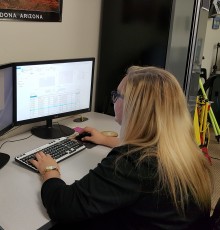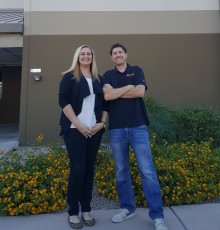MCC and BPG Designs of Phoenix partner to offer real world experience for students.
MESA, Arizona – April 27, 2016 – From the earliest attempts at geomapping during the 1832 cholera epidemic in Paris, man has sought ways to easily depict and examine an area of land. In the ensuing years, geographic mapping technology has improved dramatically. Today, Mesa Community College (MCC) students have a unique opportunity to learn the latest methods and apply that knowledge in a vast array of situations.
MCC‘s Associate in Applied Science and a Certificate of Completion in geospatial technologies ensures access to the latest tools and applications needed in the ever-expanding geomapping industry. The term “geospatial technologies” encompasses the Geographic Information Systems (GIS), Geographic Positioning System (GPS) and Remote Sensing technologies.
“Geospatial technology has broad applications,” said Karen Blevins, MCC Geography faculty, “from city planning and transportation to land resource and wildfire management, among countless others.”
Blevins’ statement is reinforced by that first successful attempt at geomapping in Paris where officials mapped cholera cases during an epidemic. Some 22 years later, London was desperate to identify the source of another outbreak. An enterprising mapmaker used the Paris example to not only track cases of the disease, but to find a contaminated water source identified by a cluster of victims.
Today, geomapping begins with satellite imaging and drones that photograph the surface of the planet. The information is entered into a geospatial database that can drill down to street level. The field has become so pervasive the U.S. Department of Labor has identified geomapping as having a bright outlook; expected to grow rapidly in the next several years. The DOL currently notes 118 occupations in the industry, many expected to have large numbers of job openings.
In 2009 Blevins worked with Tice Supplee, now the Director at Audubon Arizona, to develop an internship opportunity for MCC GIS students to update polygons representing Important Bird Areas (IBA) in the state, regions that are identified habitats of endangered species.
“It was an amazing experience and I want to continue to offer my students the opportunity to see how the technology, the industry, can help our communities and our world first hand,” Blevins said.
One MCC student pursuing an Associate in Applied Science in Geospatial Technologies, Alexis Jacobs (Tempe), who is co-enrolled at ASU, was selected for a paid internship following an MCC class project with BPG Designs of Phoenix last semester. BPG Designs offers industrial design, construction technology and mapping.
“This is the second semester we’ve offered internships for MCC geomapping students, and the first semester with the paid opportunity,” said Nik Smilovsky, BPG Mapping Manager. “There are six students participating this semester. We’re providing real world experience using the latest technology.” Smilovsky said Jacobs’ internship with BPG could result in full-time employment.
BPG’s mapping division works in a virtual 3D world, Smilovsky said, using the ESRI ArcGIS Desktop software package. “Students collect latitude and longitude at points, add a photo and attributes, such as the type and size of the tree, for example.” Smilovsky said BPG is creating online maps for DLC Resources, a large landscaping company that will use the information with Homeowners Associations to aid in making effective water-saving decisions.
“We work with MCC because we are a community-minded engineering and construction firm,” said Smilovsky, who added that he has a passion to lead young people. “At the community college level we get to grow employees within the U.S. Working with MCC was a natural fit.”
Brian Reed, who earned a Masters in GIS from ASU, is a Mapping Specialist II with BPG Designs who works closely with MCC interns including Jacobs. “The GIS community can learn from one another and the dissemination of information is key to that. This is an opportunity for students to learn how a private company employs GIS technology and professionals. We encourage students to apply the techniques and ideas learned in this program to their current or future job.”
“I have done internships in the past related to the urban planning field and saw an opportunity to get the same experience with BPG,” Jacobs said. “So far the projects and technologies I have been exposed to are incredible. Seeing real world applications for everything we discuss in class helps me understand how important it all is.”
Blevins noted that the Internet has helped people become more aware of digital mapping.
“They’re now becoming aware of the broader applications, and how it can benefit a wide range of fields. A class in geographic information systems (GIS) can help support any student’s area of study, “ Blevins said.
Just like they did in Paris and London, officials have been using geography to plot trends for decades. U.S. nuclear weapons research led to new mapping technologies in the early 1960s, and Roger Tomlinson, known as the “Father of GIS,” advocated geomapping for broader usage in 1968 when he presented a paper for regional planning. Computer hardware, software, and other mapping techniques and technologies have finally caught up with the demand for this growing industry.
“Everything we deal with in life has a spatial property,” Blevins added. “Students need problem-solving skills -- geomapping is at the intersection of a new way of thinking.”
# # #
Contacts
Dawn Zimmer, 480-461-7892, dawn.zimmer@mesacc.edu
Sally Mesarosh, 480-461-7283, sally.mesarosh@mesacc.edu
Mesa Community College is nationally recognized for its service-learning, civic engagement and innovative educational programs, which include university transfer, career and technical, workforce development, and lifelong learning. Host to 40,000 students annually, MCC offers more than 195 degrees and certificate programs at its two campuses and additional locations. MCC’s student body hails predominantly from the East Valley of Phoenix and includes Veteran, American Indian and International students who enrich the learning experience. Award-winning faculty are dedicated to student success providing the education and training that empowers MCC students to compete locally and globally. MCC is one of 10 colleges that comprise the Maricopa County Community College District. The District also includes the Maricopa Corporate College and two skill centers. For additional information, visit mesacc.edu.
Mesa Community College is accredited by the Higher Learning Commission (HLC) http://www.ncahlc.org, 800-621-7440.
The Maricopa County Community College District is an EEO/AA institution and an equal opportunity employer of protected veterans and individuals with disabilities.




